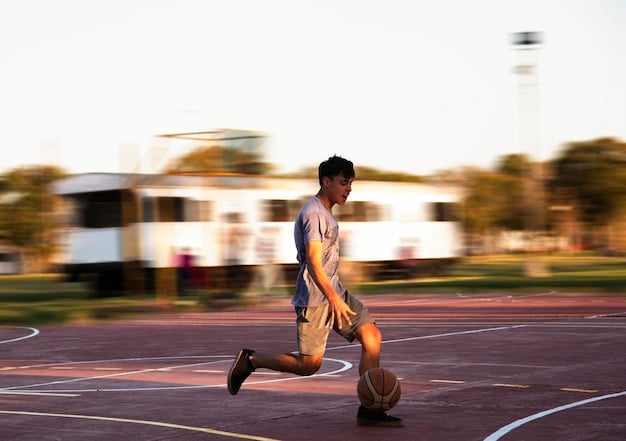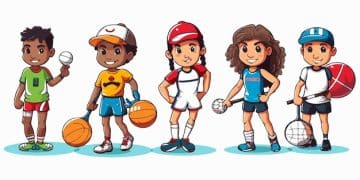Maximize Potential: The Benefits of Multi-Sport Participation for Youth Athletes

The Benefits of Multi-Sport Participation for Youth Athletes: Developing Well-Rounded Skills extend beyond physical prowess, fostering improved athleticism, reduced injury risk, and enhanced cognitive development, contributing to a more versatile and resilient young athlete.
Are you wondering if your child should focus on one sport or explore multiple? Discover The Benefits of Multi-Sport Participation for Youth Athletes: Developing Well-Rounded Skills that can shape their athletic journey.
Why Multi-Sport Participation Matters
Multi-sport participation is a growing trend among youth athletes, and for good reason. This approach involves engaging in various sports rather than specializing in just one. It offers a multitude of benefits that can significantly enhance an athlete’s overall development.
By exploring different athletic activities, young athletes can unlock a broader range of skills and experiences. This diversification not only makes them more versatile but also better prepares them for the challenges and opportunities that lie ahead.
Skill Diversification and Athleticism
One of the primary benefits of multi-sport participation is the development of a diverse skill set. Different sports require different physical and mental abilities. Engaging in a variety of sports allows athletes to develop a more comprehensive range of skills.
For example, basketball can enhance agility and hand-eye coordination, while swimming builds endurance and cardiovascular fitness. Track and field can improve speed and power, while soccer requires teamwork and strategic thinking.
- Improved overall athleticism
- Enhanced motor skills
- Better coordination and balance
This broad range of skills not only makes the athlete more versatile but also contributes to improved overall athleticism. A well-rounded athlete is better equipped to adapt to different challenges and excel in various physical activities.

Reduced Risk of Injury
Specializing in a single sport from a young age can lead to overuse injuries. Repetitive motions and constant stress on the same muscle groups can increase the risk of strains, sprains, and other musculoskeletal issues. Multi-sport participation helps to mitigate these risks.
By engaging in a variety of sports, athletes distribute the physical stress across different muscle groups and joints. This reduces the likelihood of overuse injuries and promotes more balanced physical development. Additionally, different sports can help to strengthen different areas of the body, further minimizing the risk of injury.
- Reduced overuse injuries
- Balanced physical development
- Stronger overall body
This approach ensures that no single muscle group is overloaded, allowing the body to develop holistically and reducing the potential for injury. Athletes who participate in multiple sports tend to have fewer injuries and a longer, more sustainable athletic career.
Multi-sport participation is not merely about playing different sports; it’s about fostering a holistic approach to athletic development that prioritizes long-term health and performance.
Cognitive Development and Decision-Making
Participating in multiple sports not only benefits physical development but also enhances cognitive skills. Different sports require different mental strategies and decision-making processes. Engaging in a variety of sports can sharpen an athlete’s cognitive abilities.
For example, sports like soccer and basketball require quick decision-making and strategic thinking. Athletes must constantly assess the situation, anticipate their opponents’ moves, and make split-second decisions. These cognitive challenges help to improve reaction time, problem-solving skills, and overall mental agility.
Enhanced Strategic Thinking
Every sport comes with its own set of strategic challenges. Whether it’s planning a play on the basketball court or deciding when to make a move in a soccer game, athletes are constantly engaged in strategic thinking. Multi-sport participation exposes young athletes to a broader range of strategic scenarios.
This diverse exposure can lead to enhanced strategic thinking skills. Athletes learn to adapt their strategies to different sports and situations, making them more versatile and adaptable decision-makers. The ability to think strategically is an invaluable asset not only in sports but also in academics and other areas of life.
- Improved problem-solving skills
- Better strategic planning
- Enhanced adaptability
Athletes who participate in various sports are better equipped to analyze complex situations, identify potential solutions, and make informed decisions. This cognitive flexibility is a significant advantage in both athletic and academic pursuits.

Improved Focus and Concentration
Different sports require different levels of focus and concentration. Some sports require intense bursts of focus, while others demand sustained concentration over a longer period. Multi-sport participation can help athletes develop a more versatile and resilient attention span.
For example, sports like golf and archery require intense focus and precision. Athletes must block out distractions and maintain concentration for extended periods. On the other hand, sports like basketball and soccer demand quick shifts in focus and the ability to react to changing situations.
- Greater mental resilience
- Better attention span
- Improved focus under pressure
By engaging in a variety of sports, athletes learn to adapt their focus and concentration to different demands. They become more adept at blocking out distractions and maintaining mental clarity, even under pressure. This enhanced mental discipline can benefit their performance in all areas of life.
Multi-sport participation offers a comprehensive cognitive workout, enhancing strategic thinking, improving focus, and boosting overall mental agility.
Social and Psychological Benefits
Beyond physical and cognitive advantages, multi-sport participation offers significant social and psychological benefits for young athletes. These benefits contribute to a more well-rounded and balanced development.
Participating in different sports allows athletes to interact with a wider range of teammates and coaches. This exposure can foster improved social skills, enhanced communication abilities, and a stronger sense of teamwork. It also helps athletes develop resilience and learn to navigate different social dynamics.
Enhanced Social Skills
Each sport comes with its own unique team dynamics and social norms. By participating in multiple sports, athletes are exposed to different social environments. This exposure can lead to enhanced social skills and improved communication abilities.
Athletes learn to work with different teammates, adapt to different coaching styles, and navigate various social situations. They develop the ability to communicate effectively, resolve conflicts, and build strong relationships. These social skills are invaluable assets that can benefit them throughout their lives.
- Better teamwork
- Improved communication skills
- Enhanced relationship building
Multi-sport participation offers a rich social training ground, where athletes learn to collaborate, empathize, and build lasting connections. These skills are essential for success in both personal and professional realms.
Increased Confidence and Self-Esteem
Succeeding in different sports can significantly boost an athlete’s confidence and self-esteem. Each new skill mastered and each new challenge overcome contributes to a stronger sense of self-efficacy.
Athletes who participate in multiple sports often have a broader range of accomplishments to be proud of. This diverse portfolio of achievements can lead to increased confidence and a more positive self-image. They learn to embrace challenges, persevere through adversity, and celebrate their successes, fostering a growth mindset that extends beyond the playing field.
Don’t miss out!
- Boosted self-esteem
- Increased self-efficacy
- Positive self-image
Multi-sport participation cultivates a positive feedback loop, where successes in one sport fuel motivation and confidence in others. This holistic approach to athletic development promotes not only physical prowess but also mental and emotional well-being.
The social and psychological benefits of multi-sport participation are just as crucial as the physical and cognitive advantages. By fostering strong social skills and boosting confidence, this approach helps young athletes develop into well-rounded individuals.
Long-Term Athletic Development
One of the most compelling reasons to encourage multi-sport participation is its positive impact on long-term athletic development. Focusing solely on one sport from a young age can lead to burnout, decreased motivation, and a higher risk of injury.
Multi-sport participation, on the other hand, promotes a more sustainable and enjoyable athletic journey. By diversifying their activities, athletes are less likely to experience burnout and are more likely to maintain their interest in sports over the long term. This variety also helps to prevent overuse injuries and promotes a more balanced physical development.
Avoiding Burnout
Burnout is a common issue among young athletes who specialize in a single sport. The intense pressure to perform, the repetitive training routines, and the limited exposure to other activities can lead to decreased motivation and a loss of interest in the sport.
Multi-sport participation helps to prevent burnout by providing variety and promoting a more balanced lifestyle. Athletes have the opportunity to engage in different activities, explore new skills, and interact with different teammates and coaches. This diversity keeps them engaged and motivated, ensuring that they continue to enjoy their athletic pursuits.
- Sustained motivation
- Reduced pressure to perform
- Greater enjoyment of sports
By encouraging multi-sport participation, parents and coaches can help young athletes avoid burnout and maintain a lifelong love of sports. This approach fosters a more positive and sustainable athletic experience.
Building a Foundation for Future Success
Multi-sport participation can lay a strong foundation for future athletic success. The diverse skill set, enhanced cognitive abilities, and improved social skills developed through multi-sport participation can give athletes a competitive edge.
Athletes who participate in multiple sports are often better equipped to adapt to new challenges, learn new skills, and perform under pressure. They have a more comprehensive understanding of athletic principles and a greater capacity for strategic thinking. These qualities can make them more successful in their chosen sport, whether they continue to participate in multiple activities or eventually specialize in one.
- Competitive advantage
- Greater adaptability
- Comprehensive athletic understanding
Multi-sport participation is not just about playing different sports; it’s about building a foundation for lifelong athletic success. By fostering a diverse skill set and promoting a holistic approach to development, this approach helps young athletes reach their full potential.
Multi-sport participation offers numerous benefits for youth athletes. From developing well-rounded skills to fostering social and psychological well-being, this approach sets young athletes up for success both on and off the field.
Practical Tips for Implementing Multi-Sport Participation
Implementing multi-sport participation can be a rewarding experience for young athletes, but it requires careful planning and consideration. Here are some practical tips to help parents and coaches facilitate a successful multi-sport approach.
Start by encouraging young athletes to explore different sports and activities. Let them try out various options and discover what they enjoy. It’s important to prioritize fun and engagement over specialization at a young age. As they get older, help them balance their interests and commitments to ensure they don’t get overwhelmed.
Encouraging Exploration and Discovery
The first step in implementing multi-sport participation is to encourage young athletes to explore different sports and activities. This exploration should be driven by curiosity and a desire to try new things. Parents and coaches can provide opportunities for athletes to sample various sports, attend introductory clinics, and participate in recreational leagues.
It’s important to create a supportive and non-judgmental environment where athletes feel comfortable trying new things and making mistakes. Focus on the process of learning and discovery rather than the outcome. Encourage athletes to have fun and enjoy the experience of trying different sports.
- Offer a variety of sports options
- Attend introductory clinics
- Participate in recreational leagues
By fostering a culture of exploration and discovery, parents and coaches can help young athletes identify their passions and develop a lifelong love of sports.
Balancing Interests and Commitments
As young athletes get older, they may have multiple interests and commitments. Balancing these responsibilities can be challenging, but it’s important to ensure that they don’t get overwhelmed. Parents and coaches can help athletes prioritize, manage their time effectively, and communicate their needs.
Work with athletes to create a schedule that allows them to participate in multiple sports while also leaving time for academics, family, and other activities. It’s important to be flexible and willing to adjust the schedule as needed. Encourage athletes to communicate their feelings and concerns, and provide support and guidance as they navigate their various commitments.
- Prioritize responsibilities
- Manage time effectively
- Communicate needs and concerns
Balancing interests and commitments requires open communication, flexibility, and a willingness to adapt. By working together, parents, coaches, and athletes can create a sustainable and enjoyable multi-sport experience.
| Key Benefit | Brief Description |
|---|---|
| 💪 Skill Diversification | Develops broad athletic skills. |
| 🧠 Cognitive Development | Enhances strategic thinking and focus. |
| 🤝 Social Benefits | Improves teamwork and communication. |
| 🛡️ Injury Prevention | Reduces overuse injuries and burnout. |
Frequently Asked Questions
▼
Multi-sport participation enhances skill diversification, cognitive development, social skills, and reduces the risk of overuse injuries, leading to a well-rounded athletic experience.
▼
By distributing physical stress across different muscle groups, multi-sport participation prevents overuse injuries commonly associated with specializing in a single sport.
▼
Participating in different sports improves strategic thinking, problem-solving skills, focus, and decision-making abilities, enhancing an athlete’s mental agility.
▼
Engaging in various sports allows athletes to interact with diverse teams and coaches, fostering improved communication skills, teamwork, and relationship-building abilities.
▼
Multi-sport participation prevents burnout, sustains motivation, and builds a strong foundation for future athletic success through diverse skill development and a holistic approach.
Conclusion
Embracing multi-sport participation offers a holistic approach to youth athletic development, providing a wide array of benefits from enhanced physical skills and cognitive abilities to improved social interactions and psychological well-being. By encouraging young athletes to explore various sports, we can help them develop into well-rounded individuals prepared for success both on and off the field.





